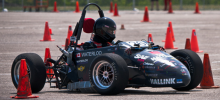If you would like to see more information on this case study, click here!
You can request this case study and a WCDE staff member will get back to you.
 The University of Waterloo Formula Motorsports (UWFM) team competes annually in the Society of Automotive Engineer’s Formula SAE Michigan competition, wherein they must design, build and compete with an open-wheeled race car, Figure 1. The competition organizers annually publish a comprehensive set of rules [3] to ensure a competitive environment and the safety of all competitors. One key requirement is that the engine must be a 4-cycle internal combustion engine with not more than 610 cc’s of displacement. To limit the power produced by the engine, an additional requirement is that all air supplied to the gasoline-fueled engine must pass through a 20 mm diameter restrictor.
The University of Waterloo Formula Motorsports (UWFM) team competes annually in the Society of Automotive Engineer’s Formula SAE Michigan competition, wherein they must design, build and compete with an open-wheeled race car, Figure 1. The competition organizers annually publish a comprehensive set of rules [3] to ensure a competitive environment and the safety of all competitors. One key requirement is that the engine must be a 4-cycle internal combustion engine with not more than 610 cc’s of displacement. To limit the power produced by the engine, an additional requirement is that all air supplied to the gasoline-fueled engine must pass through a 20 mm diameter restrictor.
AUWFM and most other University teams start with a 600 cc motorcycle engine, which is modified in various ways. The Waterloo team used a Honda CBR 600 F4i engine from 2004 until 2009. For the 2010 competition, the team was contemplating upgrading to a newer engine, the Honda 600 CBR RR. This engine was expected to offer several advantages to the team, but was expected to suffer from the same problem as the F4i engine: a dip in the torque curve below 8000 rpm. This dip in the curve was thought to be attributed to the use of the stock cam profiles on this restricted engine; this dip makes it difficult for novice drivers to achieve maximum performance on the track.
The teaching objective of this case is to illustrate a systematic approach to the design modification of a complex engineering system, in this case an internal combustion engine. Emphasis is placed on the effective use of engineering analysis, including engine simulations using Ricardo Wave. This analysis is presented to justify changes to an engine camshaft, and students are then asked to develop the final camshaft design. The case is proposed to be used in Kinematics and Dynamics of Machines (ME 321).
If you would like to see more information on this case study, click here!
You can request this case study and a WCDE staff member will get back to you.
Contact Waterloo Cases in Design Engineering
Steve Lambert
Tel: (519) 888-4728
Email: steve@uwaterloo.ca
The University of Waterloo acknowledges that much of our work takes place on the traditional territory of the Neutral, Anishinaabeg and Haudenosaunee peoples. Our main campus is situated on the Haldimand Tract, the land granted to the Six Nations that includes six miles on each side of the Grand River. Our active work toward reconciliation takes place across our campuses through research, learning, teaching, and community building, and is co-ordinated within the Office of Indigenous Relations.